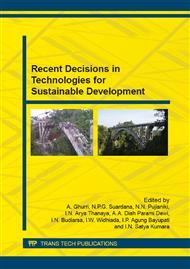[1]
National Research Council, Beach Nourishment and Protection, National Academy Press, (1995).
Google Scholar
[2]
P.A. Work, R.G. Dean. Assessment and prediction of beach-nourishment evolution, Journal of Waterway, Port, Coastal and Ocean Engineering, 121 (1995) 182-189.
DOI: 10.1061/(asce)0733-950x(1995)121:3(182)
Google Scholar
[3]
R.G. Dean. Principles of beach nourishment, in: P.D. Komar (Ed), Coastal Process and Erosion, CRC Press, Florida, 1985, pp.217-232.
Google Scholar
[4]
S. Onaka, T. Uda, T. Onuki, S. Endo, Field observation of wave and nearshore currents in the vicinity of a reef gap on Nusa Dua beach in Bali Island in Indonesia, COPEDEC, Colombo – Sri Lanka, (2003).
Google Scholar
[5]
M.O. Hayes, Geomorphology and sedimentation patterns of tidal inlets: a review, Proceedings Coastal Sediments '91, ASCE, (1991).
Google Scholar
[6]
D.Y. Lesmana, Profile Measurement and Sediment Characteristics of Sanur Beach, Dept. of Civil Engineering, Udayana University, 2006, (in Indonesian).
Google Scholar
[7]
J.I.C. A, The feasibility study on the urgent Bali Beach Conservation Project, Final Report, (1989).
Google Scholar
[8]
Research Center for Water Resources, Evaluation of the Performance of Shore Protection Structures at Sanur, Nusa Dua, and Tanah Lot, Volume I: Main Report, Final Report, Bandung, 2006, (in Indonesian).
Google Scholar
[9]
J.R.C. Hsu, C. Evans, Parabolic bay shapes and applications, Proc. Inst. of Civil Engineers, Vol. 87, 557-570, London, England, (1989).
DOI: 10.1680/iicep.1989.3778
Google Scholar
[10]
H. Hanson, N.C. Kraus, GENESIS - Generalized Model for Simulating Shoreline Change, Vol. 1. Reference Manual and Users Guide, Tech. Report CERC-89-19, U.S. Army of Engineers, Waterway Experiment Station, (1989).
DOI: 10.5962/bhl.title.48202
Google Scholar
[11]
H. Hanson, N.C. Kraus, Comparison of shoreline change obtained with physical and numerical models, Proc. Coastal Sediments'91, ASCE, 1785-1813, (1991).
Google Scholar
[12]
H. Hanson, N.C. Kraus, Shoreline response to a single transmissive detached breakwater, Proc. 22nd Coastal Engineering. Conf., ASCE, 2, 34-46, (1990).
DOI: 10.1061/9780872627765.156
Google Scholar
[13]
H. Hanson, N.C. Kraus, Numerical simulation of shoreline change at Lorain, Ohio. J. Waterway, Port, Coastal and Ocean Engineering, 117(1), (1991) 1-18.
DOI: 10.1061/(asce)0733-950x(1991)117:1(1)
Google Scholar


